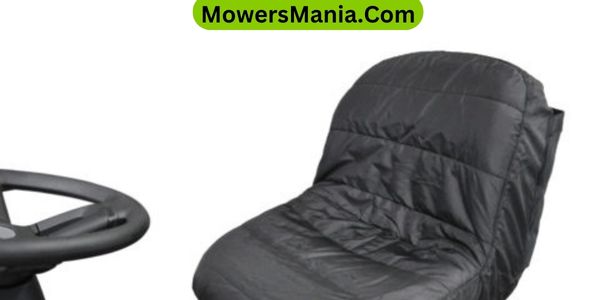Is your mower seat cover starting to look a little worse for wear? It’s the unsung hero of your lawn care routine, providing you with comfort while you tackle your yard work. But over time, it’s bound to get dirty.
The question is, can you clean it without causing any damage? In this guide, you’ll learn how to give your mower seat cover the TLC it deserves without risking any harm.

From understanding the material to selecting the right cleaning products and techniques, you’ll be equipped with the knowledge to keep your mower seat cover looking fresh and clean.
Understanding the Mower Seat Cover Material
You should start by examining the mower seat cover material to determine the best cleaning approach. Different mower seat covers are made from various materials such as vinyl, fabric, or leather.
Vinyl seat covers are durable and easy to clean, usually requiring a simple wipe down with a mild soap and water solution.
Fabric seat covers may be a bit trickier to clean, as they can absorb stains and odors. A gentle scrub with a mixture of laundry detergent and water can often do the trick, but be sure to check the manufacturer’s recommendations.
Leather seat covers require special care to avoid drying out or cracking. Using a leather cleaner and conditioner specifically designed for automotive upholstery is your best bet.
Understanding the material of your mower seat cover is crucial in determining the appropriate cleaning method to avoid damaging it. Taking the time to identify the material and following the recommended cleaning approach will help keep your mower seat cover looking its best for years to come.
Identifying Stains and Soil on the Cover
Examining the mower seat cover material will help you identify stains and soil that may require specific cleaning approaches.
When assessing the cover, pay attention to the following:
- Type of Stain: Determine if the stain is from grass, oil, grease, or other substances. Different stains may require different cleaning methods.
- Extent of Soiling: Check how deeply ingrained the soil or stains are. Light surface dirt may be easier to clean than deeply embedded grime.
- Fabric Sensitivity: Identify the type of fabric the cover is made of, as some materials are more delicate and may require gentler cleaning methods.
- Colorfastness: Test a small, inconspicuous area of the cover to see if the color bleeds or fades when exposed to cleaning solutions.
- Odor: Take note of any unpleasant odors, as this may indicate the presence of organic matter that needs specific treatment.
Selecting Safe Cleaning Products and Tools

To effectively clean the mower seat cover without causing damage, select safe cleaning products and tools that are specifically designed for the material and type of stains present.
When choosing cleaning products, consider the material of the seat cover and the type of stains you are dealing with.
For example, for fabric seat covers, a gentle fabric cleaner or upholstery cleaner can be effective, while vinyl or leather seat covers may require a specialized cleaner.
It’s important to read the labels and ensure that the cleaning products are safe for the specific material of your mower seat cover. Additionally, consider the tools you will use for cleaning.
Soft-bristled brushes, microfiber cloths, and gentle sponges are generally safe options for scrubbing and wiping down the seat cover without causing damage.
| Safe Cleaning Products and Tools | ||
|---|---|---|
| Material | Type of Stains | Recommended Cleaning Products/Tools |
| Fabric | Dirt, grass stains | Gentle fabric cleaner, soft-bristled brush |
| Vinyl | Grease, oil | Specialized vinyl cleaner, microfiber cloth |
| Leather | Ink, spills | Leather cleaner, gentle sponge |
Applying Proper Cleaning Techniques
When cleaning a mower seat cover without causing damage, it’s important to apply proper cleaning techniques using the appropriate cleaning products and tools.
To ensure the best results and prevent any potential harm to the seat cover, consider the following steps:
- Gentle Scrubbing: Use a soft-bristled brush or sponge to gently scrub the seat cover. Avoid using abrasive materials that could cause tearing or fraying.
- Mild Cleaning Solutions: Opt for mild and non-abrasive cleaning solutions specifically designed for fabric or vinyl surfaces. Harsh chemicals can cause discoloration or deterioration of the seat cover.
- Spot Testing: Before applying any cleaning solution to the entire seat cover, perform a spot test in an inconspicuous area to ensure it doesn’t cause any adverse effects.
- Proper Drying: After cleaning, ensure the seat cover is thoroughly dried to prevent mold or mildew growth. Avoid prolonged exposure to direct sunlight, as it may cause fading.
- Regular Maintenance: Implement a routine cleaning schedule to prevent dirt and debris from accumulating, making the cleaning process more manageable and reducing the risk of damage.
Drying and Protecting the Mower Seat Cover

Once you’ve cleaned the mower seat cover, make sure to properly dry it to prevent mold and mildew.
Using a protective spray can help extend the life of the cover and keep it looking new.
Be cautious about exposing the cover to direct sunlight for extended periods, as this can cause fading and potential damage.
Proper Drying Techniques
After cleaning the mower seat cover, you should ensure it’s thoroughly dried to protect it from damage and prolong its lifespan.
Here are some proper drying techniques to follow:
- Air drying: Hang the cover in a well-ventilated area, preferably outdoors, and allow it to air dry completely.
- Avoid direct sunlight: While drying, avoid exposing the cover to direct sunlight for prolonged periods as it can cause fading and damage to the fabric.
- Use of a fan: If indoor drying is necessary, use a fan to facilitate quicker drying and ensure proper air circulation.
- Regularly check for moisture: Periodically check the cover for any remaining moisture and ensure it’s completely dry before storage.
- Apply fabric protectant: Once dry, consider applying a fabric protectant to safeguard the cover from future stains and damage.
Using Protective Sprays
To further protect the mower seat cover after cleaning, you can use protective sprays to aid in drying and safeguarding the cover from potential damage.
Once the cover is clean and dry, apply a specialized protective spray designed for outdoor fabrics. These sprays create a protective barrier that helps repel water, prevent UV damage, and reduce the risk of mold and mildew.
When applying the spray, ensure the mower seat cover is completely dry to avoid trapping moisture, which could lead to mold growth. Follow the manufacturer’s instructions for the specific protective spray you choose, as application methods may vary.
Sunlight Exposure Precautions
To properly protect your mower seat cover from sunlight exposure, frequently ensure that it’s thoroughly dried and shielded with a protective spray.
Sunlight can cause the seat cover material to deteriorate over time, but by taking these precautions, you can extend its lifespan and keep it looking great.
Here are some important tips to consider:
- After cleaning the seat cover, allow it to air dry in a shaded area to prevent any sun damage.
- Use a UV protectant spray specifically designed for outdoor fabrics to shield the seat cover from harmful UV rays.
- Regularly inspect the seat cover for any signs of fading or wear caused by sunlight exposure.
- Whenever possible, park your mower in a shaded area to minimize direct sunlight exposure to the seat cover.
- Consider using a protective cover or tarp to further shield the mower seat cover from prolonged sunlight exposure.
Regular Maintenance and Care Tips
You should regularly inspect and clean your mower seat cover to prevent damage and maintain its condition. Regular maintenance and care are essential for prolonging the life of your mower seat cover.
Here are some tips to help you keep your mower seat cover in top condition:
| Maintenance Task | Frequency | Tips |
|---|---|---|
| Inspect for tears or | Every 1-2 months | Check for any tears, rips, or signs |
| damage | of wear and tear. Repair or replace | |
| the cover as needed. | ||
| Clean | Every 3 months | Use a mild soap and water solution |
| to clean the seat cover. Avoid harsh | ||
| chemicals that can damage the fabric. | ||
| Protect from sunlight | Daily | Park your mower in a shaded area or |
| exposure | use a cover to protect the seat from | |
| prolonged sunlight exposure. | ||
| Storage | During off-season | Store the mower in a dry, cool place |
Frequently Asked Questions [FAQs]
Can I Use Bleach or Other Harsh Chemicals to Clean My Mower Seat Cover?
You shouldn’t use bleach or harsh chemicals to clean your mower seat cover. They can damage the fabric and cause discoloration. Instead, opt for a mild detergent and gentle scrubbing to keep your seat cover clean without risking damage.
What Is the Best Method to Remove Stubborn Stains From My Mower Seat Cover?
To remove stubborn stains from your mower seat cover, try using a mixture of mild detergent and water. Gently scrub the stained area with a soft brush, then rinse with clean water. Avoid harsh chemicals to prevent damage.
Is It Safe to Machine Wash My Mower Seat Cover?
Yes, it’s safe to machine wash your mower seat cover. Use a gentle cycle and mild detergent. Avoid using bleach or harsh chemicals. Air dry it completely before putting it back on the mower. This will help keep your seat cover in good condition.
Can I Use a Pressure Washer to Clean My Mower Seat Cover?
Yes, you can use a pressure washer to clean your mower seat cover. Use a mild detergent and low-pressure setting. Keep the nozzle at a distance to avoid damaging the fabric. Allow it to air dry completely before reinstalling.
How Often Should I Clean and Maintain My Mower Seat Cover?
You should clean and maintain your mower seat cover regularly to prevent dirt and debris buildup. Wiping it down with a mild detergent and water solution and gentle scrubbing should keep it in good condition without damaging it.
Conclusion
So, now that you know how to clean a mower seat cover without damaging it, you can keep your equipment looking fresh and well-maintained.
By understanding the material, identifying stains, using safe products and tools, applying proper cleaning techniques, and regular maintenance, you can ensure your mower seat cover stays in great condition for years to come.
Happy mowing!



